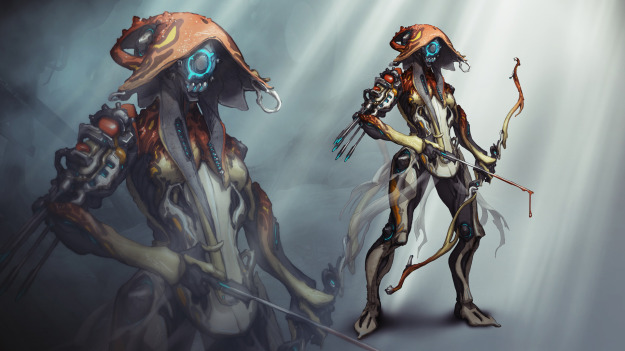Last night we managed to get a group together for Warframe– Ash, Bel and I got together and rocked some missions, it was a ton of fun. I want to dive in a little bit more to talk about why, after the initial coolness of motion and combat has settled down a bit, I’m still really interested in playing more of this game.
I started with the Volt frame, and I’ve since picked up a few other frames (Ember, Trinity, Ivara), and traded a few rare items I’d picked up for the start of a Prime frame. A “frame” is essentially a character, like in League of Legends– they have their own stats, their own unique abilities, and their own appearance. A Prime frame is essentially a souped-up version of a standard frame, with better stats and usually a unique trick or two. They can’t be bought on the store, the parts have to be found on missions and constructed.
I’ve played a LOT in the last few days. I’ve got a goodly selection of mods, I’ve got a decent sense of how to level them up and how a handful of different frames play, and I know how crafting and various other systems work. Ash has about the same knowledge of the systems with a bit of a deeper understanding of the item stats and how they interact, but less playtime and thus fewer levels on fewer frames. Bel started playing this afternoon, with basically no knowledge of the game other than what he’d read about.
Bel played the first two tutorial missions, roughly twenty or thirty minutes’ worth, and then Ash and I jumped in with fresh, unlevelled frames to join up with. The entire thing was seamless. What’s more, I had an unlocked mission that the other two did not, and I was able to load it up and bring them with me. Ash and I ran a mission that he wasn’t even close to unlocking, and when we beat it he got unlocks for the other surrounding missions, just as if he’d reached it normally. We were able to then go and fight the boss of the planet and unlock the next planet in the series. We also jumped into a mission with wildly uneven frame levels, and it worked just fine. I wasn’t overpowered and dominating the mission any more than he was underpowered and struggling. This includes story missions as well– Ash and I jumped in on several of Bel’s story missions and got XP and useful rewards, despite having played them already.
I have a hard time expressing how much I like this. Levelling up isn’t meaningless, but it is in no way an impediment to you playing with your friends. I could jump in with a max level frame with my friend who’s just started and we’d still be able to have a good time. I can carry over my progress on weapons and mods to a new frame I choose to play to get a little boost, or I can start totally fresh with an unlevelled frame and weapons with a buddy, and play at exactly their level while still benefiting– credits, XP, and levels on new frames are all worthwhile.
There’s even a player level, which rises much more slowly than everything else and requires that you pass an exam to level up. Exams can only be attempted once per day, whether you succeed or fail. Raising your player level unlocks new options for weapons, frames, and various game features like trading and factions, but has little effect on your frames themselves. What I find interesting is that it doesn’t rise with XP earned, it rises as you level up frames and weapons. In order to get a high player level, you NEED to keep trying new weapons and frames and levelling them up, so you want to level up something new with a new friend who’s joined the game.
Kodra is out of town, but I suspect he’ll like the game once we get into it and have his own set of favorite frames. I have a frame set aside to try out once we can play together, as does Ash (I believe), and none of it will feel unnecessary or like it’s holding us back. The whole setup is very elegant, and brings a “play with your friends” mentality that I found absent even in games like Borderlands, Destiny, or even the majority of MMOs, where even a mild level or gear gap was significantly noticable.
When I go on about games needing to let you play with your friends, and removing “levelling”, Warframe is a prime example of what I’m talking about. Sure, individual parts of the game have levels, and increase in level as you play, but none of them separate you from playing with other people, and the biggest “overall” level (your player level) is largely insignificant in actual gameplay. Levelling is distributed across a wide variety of parts of the game, and the sense of progression and advancement isn’t diminished.





























